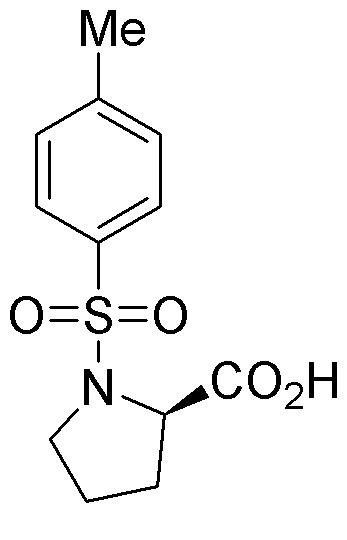Tosyl-D-proline is widely utilized in research focused on:
- Asymmetric Synthesis: This compound serves as a chiral auxiliary in the synthesis of enantiomerically pure compounds, making it invaluable in the pharmaceutical industry for developing new drugs.
- Peptide Synthesis: It is used in the formation of peptides, aiding researchers in creating specific sequences that can lead to novel therapeutic agents.
- Biocatalysis: Tosyl-D-proline acts as a catalyst in various biocatalytic reactions, enhancing reaction rates and selectivity, which is crucial in green chemistry applications.
- Drug Development: Its unique properties allow for the modification of drug candidates, improving their efficacy and reducing side effects, thus streamlining the drug discovery process.
- Research in Neuroscience: The compound is explored for its potential effects on neurological pathways, providing insights into treatments for neurological disorders.
General Information
Properties
Safety and Regulations
Applications
Tosyl-D-proline is widely utilized in research focused on:
- Asymmetric Synthesis: This compound serves as a chiral auxiliary in the synthesis of enantiomerically pure compounds, making it invaluable in the pharmaceutical industry for developing new drugs.
- Peptide Synthesis: It is used in the formation of peptides, aiding researchers in creating specific sequences that can lead to novel therapeutic agents.
- Biocatalysis: Tosyl-D-proline acts as a catalyst in various biocatalytic reactions, enhancing reaction rates and selectivity, which is crucial in green chemistry applications.
- Drug Development: Its unique properties allow for the modification of drug candidates, improving their efficacy and reducing side effects, thus streamlining the drug discovery process.
- Research in Neuroscience: The compound is explored for its potential effects on neurological pathways, providing insights into treatments for neurological disorders.
Documents
Safety Data Sheets (SDS)
The SDS provides comprehensive safety information on handling, storage, and disposal of the product.
Product Specification (PS)
The PS provides a comprehensive breakdown of the product’s properties, including chemical composition, physical state, purity, and storage requirements. It also details acceptable quality ranges and the product's intended applications.
Certificates of Analysis (COA)
Search for Certificates of Analysis (COA) by entering the products Lot Number. Lot and Batch Numbers can be found on a product’s label following the words ‘Lot’ or ‘Batch’.
*Catalog Number
*Lot Number
Certificates Of Origin (COO)
This COO confirms the country where the product was manufactured, and also details the materials and components used in it and whether it is derived from natural, synthetic, or other specific sources. This certificate may be required for customs, trade, and regulatory compliance.
*Catalog Number
*Lot Number
Safety Data Sheets (SDS)
The SDS provides comprehensive safety information on handling, storage, and disposal of the product.
DownloadProduct Specification (PS)
The PS provides a comprehensive breakdown of the product’s properties, including chemical composition, physical state, purity, and storage requirements. It also details acceptable quality ranges and the product's intended applications.
DownloadCertificates of Analysis (COA)
Search for Certificates of Analysis (COA) by entering the products Lot Number. Lot and Batch Numbers can be found on a product’s label following the words ‘Lot’ or ‘Batch’.
*Catalog Number
*Lot Number
Certificates Of Origin (COO)
This COO confirms the country where the product was manufactured, and also details the materials and components used in it and whether it is derived from natural, synthetic, or other specific sources. This certificate may be required for customs, trade, and regulatory compliance.


